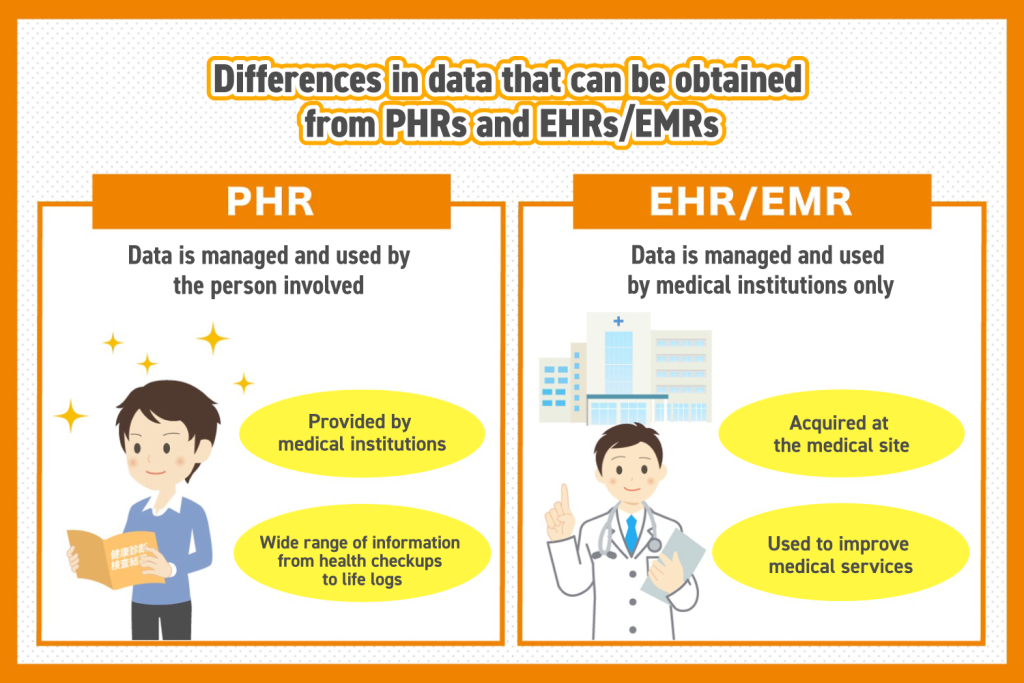A Personal Health Record (PHR), also known as a lifelong electronic health record, is a system that enables individuals to manage and utilize data related to their health and medical care. While Electronic Health Records (EHRs) and Electronic Medical Records (EMRs) are also used in the medical field, the type and scope of data they contain differ. This article explores the nature of the data captured by PHRs and how they differ from EHRs and EMRs.
What Is a Personal Health Record (PHR)?
A PHR is a system for centralizing medical and health-related data on a specific individual, allowing them to manage and utilize this information independently.
Main Data Types Captured in PHRs:
- Lifelog data (weight, blood pressure, exercise, pulse, diet, sleep, etc.)
- Data from medical institutions regarding checkups, tests, and medications (with patient consent)
- Health checkup results
- Medical history from childhood
- Allergy history and treatment details
- Past experiences and progress of pregnancy or childbirth
Data Collection Characteristics:
PHRs are managed by individuals on personal devices such as smartphones, rather than by medical institutions. Regardless of the healthcare provider or consultation interval, all information is chronologically organized under a single individual record, without duplication.
Data recorded in a PHR is not limited to information provided by healthcare professionals. It may also include data generated during routine physical activity, pregnancy, or childbirth—even without hospital visits.
Additionally, lifelog data obtained from smartphone applications or wearable devices can be integrated into PHRs. Even when the individual is healthy, PHRs continue to accumulate everyday data.
What Are EHRs and EMRs?
EHRs and EMRs also contain medical data, but they differ from PHRs in the scope and intended usage of the information.
What Is an Electronic Health Record (EHR)?
An EHR is a system that enables hospitals and clinics to share a patient’s medical data across different institutions. It includes information such as:
- Diagnoses
- Test results
- Treatments and medications
- Medical history
- Basic biometric data (e.g., blood pressure, weight, allergies)
Unlike PHRs, EHRs do not capture everyday data such as lifelog information. However, EHRs enable medical professionals to quickly understand a patient’s condition and history at the first consultation, allowing for more effective treatment.
What Is an Electronic Medical Record (EMR)?
An EMR is similar to an EHR in the type of data it records—diagnoses, test results, treatments, medications, and medical history. However, EMRs are used exclusively within a single medical institution and are not designed for sharing across facilities.
Essentially, EMRs are a digital replacement for the traditional paper medical record. They are intended for internal use by healthcare professionals and are not accessible or managed by patients.
Differences in Data Between PHRs and EHRs/EMRs

The key differences lie in the scope of the data and the entities managing it.
- PHRs are managed by individuals and include a broader range of data, such as health checkups and daily lifelog entries, in addition to information shared by medical institutions.
- The purpose of a PHR is to offer individuals and families a comprehensive view of their health and medical history. PHRs are expected to contribute to improved emergency care, preventative health measures, and long-term wellness.
- EHRs and EMRs, on the other hand, are managed by healthcare providers. They include only the data generated during medical consultations and treatments, and their primary function is to enhance the quality and efficiency of healthcare services.
PHRs as Tools for Managing Personal Health Data
PHRs are unique in that they collect and manage a wide variety of personal health data. In contrast, EHRs and EMRs manage only the data obtained through clinical encounters, making this the primary distinction.
MDV’s “karteco” is a PHR application that allows users to view medical records and health checkup results from partner medical institutions via their personal smartphones, tablets, or PCs. With karteco, users can better understand their treatment plans and communicate more effectively with healthcare providers. Additional features include autonomic balance measurement and disease risk prediction.
Try the 7-day free trial and discover more about your health with karteco.




